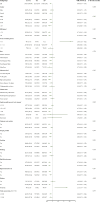Relationship between uric acid and depression in American adults: findings from NHANES, 2005-2020
- PMID: 40621557
- PMCID: PMC12226466
- DOI: 10.3389/fpsyt.2025.1544266
Relationship between uric acid and depression in American adults: findings from NHANES, 2005-2020
Abstract
Background: At present, the role of uric acid in mental disorders is receiving increasing attention, but its relationship with depression is controversial, and previous studies have corresponding limitations. The relationship between them has not been fully elucidated.
Objective: The purpose of this study is to explore the relationship between uric acid and depression in American adults using data from the National Health and Nutrition Examination Survey (NHANES).
Methods: This cross-sectional study included participants from the National Health and Nutrition Examination Survey 2011-2020. Use logistic regression and restricted cubic spline analysis to investigate the relationship between uric acid and depression. The interactions between variables were determined using subgroup analysis and described in a forest plot.
Results: 37033 participants were included in this study, with depression patients accounting for 8.95%. The uric acid levels in the depression group and nondepression group were 317.69 μ mol/L and 323.34 μ mol/L, respectively, with the former having significantly lower uric acid levels than the latter. In the fully adjusted model, participants in the third tertile of uric acid showed a significant correlation (P=0.002, OR; 0.85 (0.76 ~ 0.94)) with a higher risk of depression compared to participants in the first tertile. There is an approximately linear negative correlation between uric acid and depression (P for nonlinear=0.360), and the OR value of uric acid is 1 when the uric acid value is 312.20 μ mol/L.
Conclusions: Current research suggests that serum uric acid is associated with depression in American adults. More discoveries and causal relationships require further investigation.
Keywords: NHANES; depression; disease marker; public health; uric acid.
Copyright © 2025 Lai, Xie, Zeng, Cheng, Liu, Long, Peng, Hu and Du.
Conflict of interest statement
The authors declare that the research was conducted in the absence of any commercial or financial relationships that could be construed as a potential conflict of interest.
Figures



References
-
- World Health O . Depression and other common mental disorders: global health estimates (2017). Available online at: https://iris.who.int/handle/10665/254610. (Accessed June 26, 2024).
-
- Evans-Lacko S, Aguilar-Gaxiola S, Al-Hamzawi A, Alonso J, Benjet C, Bruffaerts R, et al. Socio-economic variations in the mental health treatment gap for people with anxiety, mood, and substance use disorders: results from the WHO World Mental Health (WMH) surveys. Psychol Med. (2018) 48:1560–71. doi: 10.1017/s0033291717003336 - DOI - PMC - PubMed
LinkOut - more resources
Full Text Sources
Research Materials

